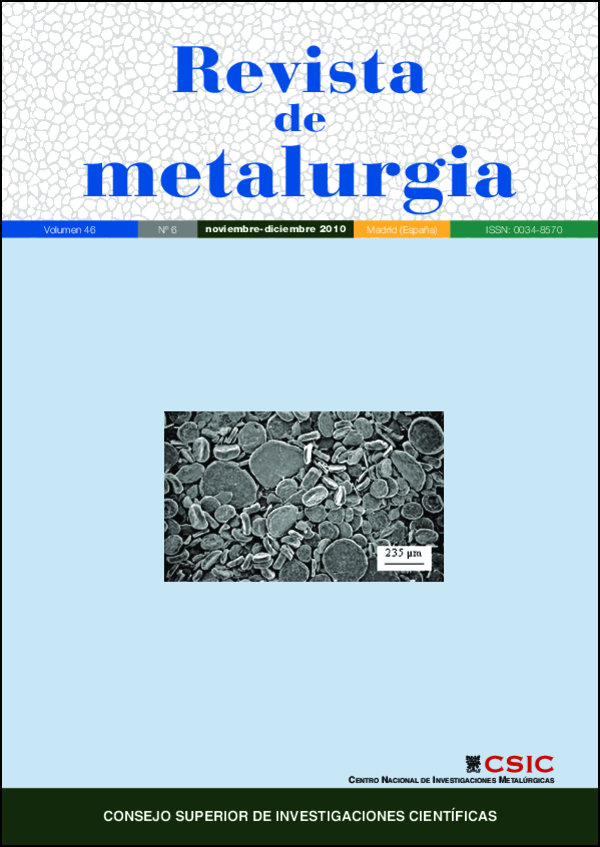Mechanochemical synthesis of a nanocrystalline thermoelectric compound
DOI:
https://doi.org/10.3989/revmetalmadrid.1020Keywords:
Solid state chemical reaction, Structural defects, αPbO-Te system, PbTeAbstract
Solid state chemical reactions were studied during high energy ball milling. Mechanosynthesis (MSY) of mixtures of high purity αPbO and Te powders under atmospheric conditions were processed. This process was selected to minimize technical difficulties as those commonly found in conventional processes involving melting- growth or sublimation of starting materials. It has been found that as particle size is reduced, structural defects are increased and hence solid state chemical reactions are enhanced. In the MSY of αPbO-Te, the phases formed are the same as those formed during conventional process (melt-growth). The alloyed powders obtained were characterized by X-ray diffraction, transmission electron microscopy and high resolution transmission electron microscopy.
Downloads
References
[1] J. Schilz, M. Riffel, K. Pixius, H.J. Meyer, Powder Technol. 105 (1999) 149-154. doi:10.1016/S0032-5910(99)00130-8
[2] O. Tae, C. Jae, H. Dow, Scripta Metall. Mater. 32/ 4 (1995) 595-600. doi:10.1016/0956-716X(95)90843-9
[3] T.J. Zhu, Y.Q. Liu y X.B. Zhao,Mater. Res. Bull 43 (2008) 2.850-2.854.
[4] V. Muñoz, A. Lasbley, S. Klotz, R. Triboulet, J. Crystal Growth 196 (1999) 71-76. doi:10.1016/S0022-0248(98)00882-3
[5] N. Bouad, R.M.Marin y J.C. Tédenac, J. Alloys Compd. 297 (2000) 312-318. doi:10.1016/S0925-8388(99)00611-8
[6] H. Rojas y D. Jaramillo., Superficies y Vacío 21/ 1 (2008) 11-15.
[7] H. Rojas-Chávez, F. Reyes-Carmona, G. Plascencia y D. Jaramillo-Vigueras, Mater. Sci. Forum 644 (2010) 69-74. doi:10.4028/www.scientific.net/MSF.644.69
[8] M. Hosokawa, K. Nogi, M. Naito y T. Yocoyama, Nanoparticle Technology Handbook, ELSEVIER, The Netherlands, 2007.
[9] R. Ferro y A. Saccone, Intermetallic Chemistry, Pergamon-Elsevier, Great Britain, 2008.
[10] A. Oufkir, M. Dutreilh, P. Thomas, J.C. Champarnaud-Mesjard, P. Marchet y B. Frit, Mater. Res. Bull. 36 (2001) 693-703. doi:10.1016/S0025-5408(01)00534-7
[11] I. Barin, Thermochemical data of pure substances, 3rd Ed.,Weinheim, New York, VCH, 1995. doi:10.1002/9783527619825
[12] A. Farghalli, A.Mohamed y Y. Xun,Mater. Sci. Eng. A 354 (2003) 133-139. doi:10.1016/S0921-5093(02)00936-X
[13] H. Beyer, J. Nurnus, H. Böttner, A. Lambrecht, E. Wagner y G.Bauer, Phys. E 13 (2002) 965- 968. doi:10.1016/S1386-9477(02)00246-1
Downloads
Published
How to Cite
Issue
Section
License
Copyright (c) 2010 Consejo Superior de Investigaciones Científicas (CSIC)

This work is licensed under a Creative Commons Attribution 4.0 International License.
© CSIC. Manuscripts published in both the printed and online versions of this Journal are the property of Consejo Superior de Investigaciones Científicas, and quoting this source is a requirement for any partial or full reproduction.All contents of this electronic edition, except where otherwise noted, are distributed under a “Creative Commons Attribution 4.0 International” (CC BY 4.0) License. You may read here the basic information and the legal text of the license. The indication of the CC BY 4.0 License must be expressly stated in this way when necessary.
Self-archiving in repositories, personal webpages or similar, of any version other than the published by the Editor, is not allowed.
















